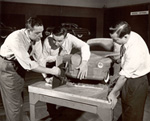
Design and the Automobile in American Life and Society
Cars make cultural as well as personal statements—the designs of the cars we buy reveal a great deal about both our society and our selves. When Buick discovered in the 1990s that the average age of its customers had risen to 68, for example, it hired Tiger Woods as a spokesperson and designed a sports car christened the Bengal to appeal to successful young professionals. Buick’s choice of pitchman and car—and their subsequent decision not to bring it to market—tells us much about America before and after September 11, 2001.
In his first essay on the history of auto design, David Gartman shows that cars have only rarely and belatedly come to be treated seriously by scholars as aesthetic objects with cultural significance, and that this lack of attention has stemmed from scholarly prejudice against the car’s practical function as a transportation device. Then, in his second essay, Gartman examines more closely the tense relationship between engineers and designers in the auto industry, a relationship always shaped by cultural ideas about gender, with “pretty boy” designers having to establish their masculinity against the “tough guy” engineers.
About the Project | Credits | Contact Us | Student & Teacher Resources | Site Map
©2004-2010 Automobile in American Life and Society
